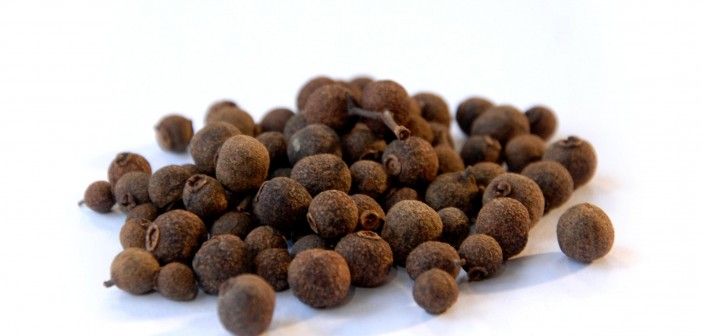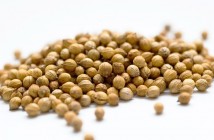People often ask, “What spices are in allspice?” Allspice is one of the most misunderstood spices. It is in its own right a single spice from an evergreen tropical tree known as Pimenta dioica. It is not a blend of “all spices.” Unripe berries are harvested from the plant and sun-dried until brown. Dried allspice berries resemble large brown peppercorns, with slightly reddish hue. Allspice takes its name from its flavor and aroma, which tastes and smells like a combination of spices, especially nutmeg, cinnamon, cloves, and peppercorn.
Taste and Aroma
Allspice flavor is sweetly pungent and fragrant. A reminiscent of nutmeg, cinnamon, and cloves, with peppery overtones. Most of the flavor comes from the shell rather than in the seeds it contains.
Pairing Spices
Cardamom, cinnamon, cloves, coriander seed, cumin, fennel seed, ginger, juniper, mustard seed, nutmeg, peppercorn, turmeric
Complements
Complements best with beef, chicken, curries and curry powder, fruits and jams, meats, especially braised, grilled or roasted, pumpkin, and winter squash.
Also complement well with root vegetables, spinach, meat and vegetable soups, esp. tomatoes, roast meats, gravies, marinades and sauces, seafood, especially shellfish, pickles, relishes chutneys, and preserves (as a whole spice), cakes, pies and biscuits
Culinary Uses
Recipes using Allspice
Regional Cuisines: Caribbean, especially Jamaican, Mexican, Middle Eastern, North American, Indian.
Allspice is also known as Jamaica Pepper. The best-quality allspice comes from Jamaica, which also produces most of the world’s supply. Not surprisingly, allspice plays an important role in Caribbean cuisine, and is an essential ingredient in Jerk seasoning — the Jamaican signature mixture used to rub onto chicken, meat, or fish before grilling. Allspice is a common ingredient in spice blends and curries across regions, especially in those designed for seasoning seafood or meats.
Another major use of allspice is the pickling and preservation of fish and meat. In the Spanish dish escabeche, fish is first fried and then preserved after marinated in an mixture of vinegar, oil, and whole allspice. The Scandinavians uses allspice for their famous pickled herring.
Thanks to its gentle and warm flavor, allspice finds its way to sweet baking goods and mulled drink and becomes a favorite substitute for cloves. Allspice also complements well with spinach, root vegetables, and vegetable soups. The English uses it in fruit-based desserts and sweet baking; the Middle East in kibbeh, a dish of ground lamb with bulgar wheat ; and the Moroccans in tagines, slow cooking stews in a unique earthenware with a tall, conical lid. In the United States, it is what makes the “Cincinnati-style” chili and the pumpkin pie kick.
Add allspice early in cooking. Use ground allspice unless you plan to remove the berries after cooking, but use whole allspice berries when you do not want the dark-brown powder to color the dish. Allspice berries are easy to crush and can used in replace of ground allspice for soups, stews, and curries. For a flavorful pepper alternative, add a small amount of allspice berries into the pepper mill. The sweetly warm flavor of the allspice complements the freshly ground pepper very well when ground.
Buying and Storing
Allspice can be bought whole or ground. Whole berries that look like large, brown peppercorns, with consistent dark, reddish-brown color are preferable. Ground allspice should be rich in dark brown color and somewhat oily when rubbed between thumb and forefinger. When kept in an airtight container away from light and humidity, whole allspice will retain its flavor for up to three years and ground allspice up to 18 months. Same as cloves, the berries contains a lot of essential oil and can be revived easily if it has been sitting on shelf for too long.
Prepared spice mixtures using allspice are also available for purchase in spice specialty stores or online:
Middle Eastern Kibbeh Spice Blend
Health Benefits
Same as clove, allspice contains eugenol, a volatile oil often used as an antiseptic and an anesthetic in relieving muscle pain or toothache. Although tiny, allspice berries house 25 active phenols, a category of powerful antioxidant for preventing cellular damage. Additional health benefits of allspice include:
- High blood pressure, diabetes, and obesity
- Indigestion, flatulence, abdominal pain, vomiting, and diarrhea
- Heavy menstrual periods
- Menopause problems
Caution
- Allspice essential oil may cause allergic reactions in sensitive skin.
- Allspice can slow blood clotting and may increase bleeding during and after surgery. Suspend use of allspice at least two weeks before a surgery.






